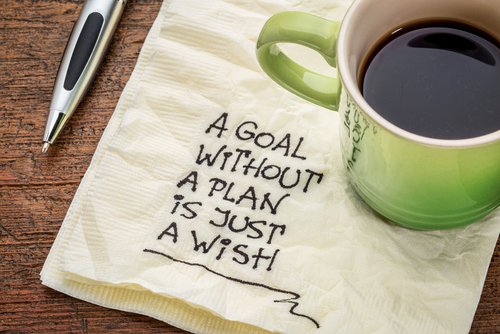Happy new year! I think we can say that, although without a doubt this year will continue to present some challenges. It is however, still as important as ever to continue to talk about your small business, but be sensitive to the ever changing landscape. At this time of year, everyone is normally talking about strategy and planning, this year should be no different. Further to conversations recently with our clients we wanted to share our “Marketing Strategy Check List” to help guide you in your thinking.
Let’s first start by defining what we mean and explaining the difference between a marketing strategy and marketing plan.
Marketing Strategy. The CIM defines a marketing strategy as “The set of objectives which an organisation allocates to its marketing function to support the overall business strategy, together with the broad methods chosen to achieve these objectives.
Marketing Plan The CIM defines a marketing plan as as “A written plan, usually in-depth, describing all activities involved in achieving a particular marketing objective and their relationship to one another in both time and importance.“
Marketing Strategy Check List
Below we share our top 9 tips to consider when you write your marketing strategy. Don’t forget that it is really important to include all key stakeholders to the process as this will help encourage buy in across the team.
- Define what you are trying to achieve?
This is the start point for any marketing activity. If you don’t know which direction you wish to head in then it is difficult to get there. Ensure that your objectives are SMART (Specific, Measured, Achievable, Relevant and Timed). When working with my clients we generally aim to develop about 5-6 key objectives.
- Visualise your Target Audience
Understanding your target audience underpins all of your marketing activity. The first part of this journey is to visualise them. I was working with a new client recently to define their target audience, they were a florist. As part of this exercise we not only defined who their potential client was but we also sourced pictures to bring it to life. Some small businesses give their target audiences a name and I love this idea because it really helps to bring them to life. Meet Susie – she is my perfect client!

- Review your historical marketing success
This is a really important step that many people forget. If you don’t know what marketing did/ did not work for you, you could continue to repeat the same mistakes.
Taking us back to Susie, our florist. She saw some great success around Valentines day last year with her marketing campaign. She took time to build a bespoke package which included flowers and chocolates. The package was promoted through Instagram advertising. It was a success! She achieved strong engagement, grew her Instagram following and her revenue was +20% YOY for the Valentines Day product. Definitely something repeat for this year.
- Consider the 5 P’s (Price, Product, Place, Promotion and People
The Five P’s are the foundation of marketing theory and by working through them you pretty much cover all of the important stuff. In price and product we consider what the right package looks like for our customers. Place is where we are going to sell our products (which media to use) and of course people is the resource behind implementing the marketing activity.
- Brainstorm your Content
You have probably heard the saying “Content is King” and that is true in today’s didigal world. There are so many ways we can connect with our target audience including: blog articles, social media, email marketing, advertising and that is just in the digital space. There are also different formats you can take. Typically editorial, websites, video, imagery and now podcasts are becoming increasingly more popular. Take some time to plan out your content across the year. Answer questions for your target audience, respond to their needs and demonstrate your expertise.
- Review your customer journey
Understanding the journey that customers take from enquiry, purchase to consumption is important. For businesses such as hotels, florists, shops, cafes, restaurants, etc there will also be a physical element to also consider. If you are a boutique hotel for example, the customer journey starts when the potential customer visits your website to understand more about your product. From there how do you encourage someone to come and stay with you? This then continues into the actual stay experience. Understanding this process is key, so you can make it the best experience it can be. Your ultimate aim is to encourage your customers to recommend you and return.
- Build your Creative assets
Once you have a clear idea of what you are trying to achieve with your business, your proposition and have some direction, the next step is to build a marketing campaign to achieve your goals. Creative is an important part of that process as it will help your audience to connect and resonate with you. Always remember to keep things simple. Be single minded in your call to action and to find impactful imagery or creative.

- Write your Marketing plan
Your marketing plan is your a tactical summary of how you are going to achieve your marketing strategy – your “to do list” if you like. As part of this it is important to include the media you wish to use, their reach, proposition plus for tracking purposes ensure you capture the budget. This will help you to keep a track of all of your marketing spend for the year.
- Measure Success!
A key part of your marketiing process and one which so often gets over looked. Tracking how successful your activity has been will help to guide you to do more of what works and stop doing what does not. In today’s digital world we can see this easily through website visitor figures and engagement on the site, email open and click through rates plus social media engagement.
I hope that the above check list helps you when you are building your 2021 marketing strategy. Let us know how you got on and of course if you would like some help to get started please get in touch.
We also wanted to share some resources which may help – our “Definitive guide to marketing strategy”, details of our marketing strategy master class running on 10 February and our 9-module online programme.
Sources:

There are some brilliant Marketing Tips here for all businesses. A Marketing Strategy is so important for businesses! Something many businesses do not think about is measuring their activity especially your marketing campaign. Great blog to help businesses to grow!
Thanks Bettina for your comments, I am pleased you found the article useful. You are so right that to have visibility and measure the impact your marketing is so important. Simply do more of what works and hold on doing the elements which are not as successful.